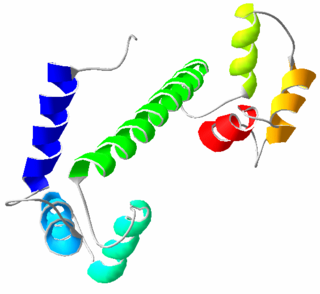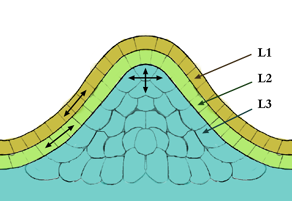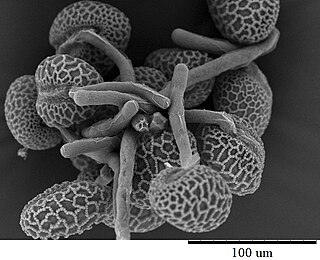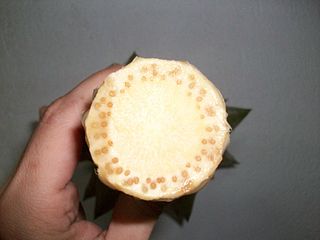Related Research Articles

Arabidopsis thaliana, the thale cress, mouse-ear cress or arabidopsis, is a small plant from the mustard family (Brassicaceae), native to Eurasia and Africa. Commonly found along the shoulders of roads and in disturbed land, it is generally considered a weed.

Fertilisation or fertilization, also known as generative fertilisation, syngamy and impregnation, is the fusion of gametes to give rise to a zygote and initiate its development into a new individual organism or offspring. While processes such as insemination or pollination, which happen before the fusion of gametes, are also sometimes informally referred to as fertilisation, these are technically separate processes. The cycle of fertilisation and development of new individuals is called sexual reproduction. During double fertilisation in angiosperms, the haploid male gamete combines with two haploid polar nuclei to form a triploid primary endosperm nucleus by the process of vegetative fertilisation.

Calmodulin (CaM) (an abbreviation for calcium-modulated protein) is a multifunctional intermediate calcium-binding messenger protein expressed in all eukaryotic cells. It is an intracellular target of the secondary messenger Ca2+, and the binding of Ca2+ is required for the activation of calmodulin. Once bound to Ca2+, calmodulin acts as part of a calcium signal transduction pathway by modifying its interactions with various target proteins such as kinases or phosphatases.

The meristem is a type of tissue found in plants. It consists of undifferentiated cells capable of cell division. Cells in the meristem can develop into all the other tissues and organs that occur in plants. These cells continue to divide until they become differentiated and lose the ability to divide.

A pollen tube is a tubular structure produced by the male gametophyte of seed plants when it germinates. Pollen tube elongation is an integral stage in the plant life cycle. The pollen tube acts as a conduit to transport the male gamete cells from the pollen grain—either from the stigma to the ovules at the base of the pistil or directly through ovule tissue in some gymnosperms. In maize, this single cell can grow longer than 12 inches (30 cm) to traverse the length of the pistil.

Self-pollination is a form of pollination in which pollen from the same plant arrives at the stigma of a flower or at the ovule. There are two types of self-pollination: in autogamy, pollen is transferred to the stigma of the same flower; in geitonogamy, pollen is transferred from the anther of one flower to the stigma of another flower on the same flowering plant, or from microsporangium to ovule within a single (monoecious) gymnosperm. Some plants have mechanisms that ensure autogamy, such as flowers that do not open (cleistogamy), or stamens that move to come into contact with the stigma. The term selfing that is often used as a synonym, is not limited to self-pollination, but also applies to other type of self-fertilization.
Self-incompatibility (SI) is a general name for several genetic mechanisms that prevent self-fertilization in sexually reproducing organisms, and thus encourage outcrossing and allogamy. It is contrasted with separation of sexes among individuals (dioecy), and their various modes of spatial (herkogamy) and temporal (dichogamy) separation.

Heterostyly is a unique form of polymorphism and herkogamy in flowers. In a heterostylous species, two or three morphological types of flowers, termed "morphs", exist in the population. On each individual plant, all flowers share the same morph. The flower morphs differ in the lengths of the pistil and stamens, and these traits are not continuous. The morph phenotype is genetically linked to genes responsible for a unique system of self-incompatibility, termed heteromorphic self-incompatibility, that is, the pollen from a flower on one morph cannot fertilize another flower of the same morph.

A primordium in embryology, is an organ or tissue in its earliest recognizable stage of development. Cells of the primordium are called primordial cells. A primordium is the simplest set of cells capable of triggering growth of the would-be organ and the initial foundation from which an organ is able to grow. In flowering plants, a floral primordium gives rise to a flower.
Peptide signaling plays a significant role in various aspects of plant growth and development and specific receptors for various peptides have been identified as being membrane-localized receptor kinases, the largest family of receptor-like molecules in plants. Signaling peptides include members of the following protein families.
HOTHEAD is an Arabidopsis thaliana gene that encodes a flavin adenine dinucleotide-containing oxidoreductase. This gene has a role in the creation of the carpel during the formation of flowers through the fusion of epidermal cells. Observations of reversion of the hothead phenotype and genotype led to the suggestion that the plants were able to "remember" the sequences of genes present in their ancestors, possibly through a cache of complementary RNA. This report attracted broad attention, and alternative explanations were suggested. Later research suggested that the supposed reversion phenomenon was due to the plants having a pronounced bias towards outcrossing, rather than self-fertilizing at high rates, as is typical for A. thaliana.
Arabinogalactan-proteins (AGPs) are highly glycosylated proteins (glycoproteins) found in the cell walls of plants. Each one consists of a protein with sugar molecules attached. They are members of the wider class of hydroxyproline (Hyp)-rich cell wall glycoproteins, a large and diverse group of glycosylated wall proteins.

Detlef Weigel is a German American scientist working at the interface of developmental and evolutionary biology.
Lewis Jeffrey Feldman is a professor of plant biology at the University of California, Berkeley, Director of the University of California Botanical Garden and previously Associate Dean for Academic Affairs in the College of Natural Resources. He is in the Department of Plant and Microbial Biology. Feldman has taught at Berkeley since 1978. He received Berkeley's Distinguished Teaching Award in 1996. Feldman's research focuses on regulation of development in meristems/stem cells, root gravitropism, and redox regulation of plant development.
Feronia, also known as FER or protein Sirene, is a recognition receptor kinase found in plants. FER plays a significant part in the plant immune system as a receptor kinase which assists in immune signaling within plants, plant growth, and plant reproduction. FER is regulated by the Rapid Alkalinization Factor (RALF). FER regulates growth in normal environments but it is most beneficial in stressful environments as it helps to initiate immune signaling. FER can also play a role in reproduction in plants by participating in the communication between the female and male cells. FER is found in and can be studied in the organism Arabidopsis thaliana.

The monocots are one of the two major groups of flowering plants, the other being the dicots. In order to reproduce they utilize various strategies such as employing forms of asexual reproduction, restricting which individuals they are sexually compatible with, or influencing how they are pollinated. Nearly all reproductive strategies that evolved in the dicots have independently evolved in monocots as well. Despite these similarities and their close relatedness, monocots and dicots have distinct traits in their reproductive biologies.

Micropeptides are polypeptides with a length of less than 100-150 amino acids that are encoded by short open reading frames (sORFs). In this respect, they differ from many other active small polypeptides, which are produced through the posttranslational cleavage of larger polypeptides. In terms of size, micropeptides are considerably shorter than "canonical" proteins, which have an average length of 330 and 449 amino acids in prokaryotes and eukaryotes, respectively. Micropeptides are sometimes named according to their genomic location. For example, the translated product of an upstream open reading frame (uORF) might be called a uORF-encoded peptide (uPEP). Micropeptides lack an N-terminal signaling sequences, suggesting that they are likely to be localized to the cytoplasm. However, some micropeptides have been found in other cell compartments, as indicated by the existence of transmembrane micropeptides. They are found in both prokaryotes and eukaryotes. The sORFs from which micropeptides are translated can be encoded in 5' UTRs, small genes, or polycistronic mRNAs. Some micropeptide-coding genes were originally mis-annotated as long non-coding RNAs (lncRNAs).
Cysteine-rich proteins are small proteins that contain a large number of cysteines. These cysteines either cross-link to form disulphide bonds, or bind metal ions by chelation, stabilising the protein's tertiary structure. CRPs include a highly conserved secretion peptide signal at the N-terminus and a cysteine-rich region at the C-terminus.
June Nasrallah is Barbara McClintock Professor in the Plant Biology Section of the School of Integrative Plant Science at Cornell University. Her research focuses on plant reproductive biology and the cell-cell interactions that underlie self-incompatibility in plants belonging to the mustard (Brassicaceae) family. She was elected to the US National Academy of Sciences in 2003 for this work and her contributions generally to our understanding of receptor-based signaling in plants.
Elizabeth Haswell is an American biologist who is a professor and Howard Hughes Medical Institute-Simons Faculty Scholar at the Washington University in St. Louis. She was elected Fellow of the American Association for the Advancement of Science in 2021.
References
- 1 2 Vernonica Franklin-Tong publications indexed by Google Scholar
- ↑ "Vernonica Franklin-Tong | Royal Society". royalsociety.org.
- 1 2 "Royal Society recognizes the outstanding contribution of local woman to science research". tenby-today.co.uk. Tenby Observer. Retrieved 2021-05-16.
- 1 2 3 4 5 6 "Professor Noni Franklin-Tong". birmingham.ac.uk. University of Birmingham. Retrieved 2021-05-16.
- ↑ Tong, Vernonica Elsa (1986). The genetics of self-incompatibility in Papaver rhoeas L. (PhD thesis). University of Birmingham. OCLC 911146126.
- ↑ Vernonica Franklin-Tong publications from Europe PubMed Central
- ↑ Vernonica Franklin-Tong publications indexed by the Scopus bibliographic database. (subscription required)
- ↑ "Breakthrough in breeding technologies". birmingham.ac.uk. University of Birmingham. Retrieved 2021-05-16.
- ↑ Anon (2010). "Investigating the PrpS-PrsS (pollen & pistil SI determinant) interaction". ukri.org. UK Research and Innovation . Retrieved 2021-05-16.